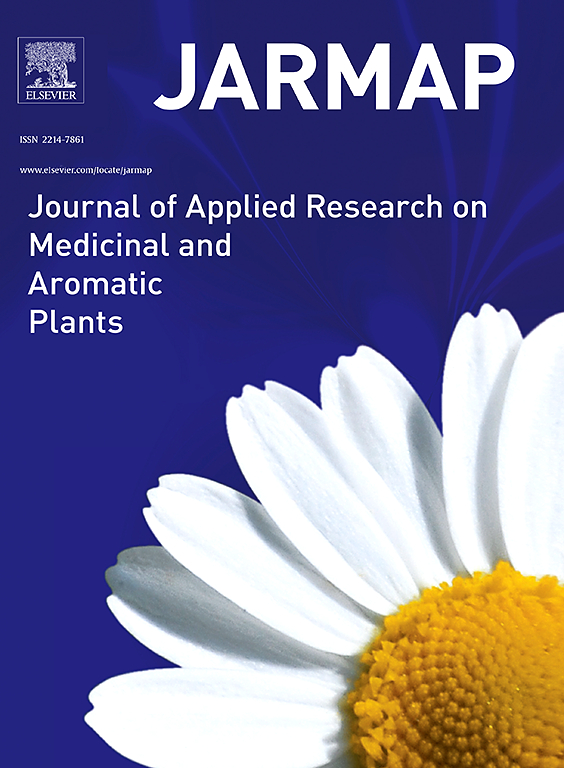Characterizing trait-specific populations and genetic diversity patterns in clary sage (Salvia sclarea L.) using SSR markers
IF 3.6
2区 农林科学
Q1 PLANT SCIENCES
Journal of Applied Research on Medicinal and Aromatic Plants
Pub Date : 2025-05-01
DOI:10.1016/j.jarmap.2025.100646
引用次数: 0
Abstract
Clary sage (Salvia sclarea L.) is an aromatic and medicinal herb grown widely across Europe, Western Asia, Maghreb, the Mideast, and countries like India. The purpose of this study was to assess genetic diversity of clary sage genotypes from the Western Himalayas, aiming to support future breeding efforts. A total of 72 genotypes of clary sage from six distinct populations were examined using 49 simple sequence repeat markers. In total, 323 alleles were detected ranging from 1 to 16 with an average of 6.54 alleles per locus. Among these, 78.33 % were common alleles, 1.86 % were rare, and 19.81 % were frequent alleles. The results revealed an overall polymorphic information content of 93.88 %, with an average of 0.71 ranging from 0.00 to 0.93 at each marker locus, indicating high genetic variability among the studied material. The detected heterozygosity (0.52) was lower than expected heterozygosity (0.71), pointing a heterozygotes deficit populations. Analysis of variance showed considerable variability for biomass yield. Molecular analysis of variance (AMOVA) showed that genetic diversity was greater within individuals than among populations. Unweighted neighbour-joining, principal coordinate analysis, and population structure showed that the genotypes from different geographic regions and various biomass yield groups were predominantly admixed across clusters. The cluster-III represented the Bharmour population was the highest biomass performer group. The observed diversity patterns will facilitate plant breeders to make choices for breeding programs aiming for higher biomass yield in this plant.
利用SSR标记分析鼠尾草(Salvia sclarea L.)的性状特异性群体和遗传多样性模式
鼠尾草(Salvia sclarea L.)是一种芳香和药用草本植物,广泛生长在欧洲、西亚、马格里布、中东和印度等国家。本研究的目的是评估西喜马拉雅地区鼠尾草基因型的遗传多样性,旨在为今后的育种工作提供支持。利用49个简单序列重复标记对6个不同居群的鼠尾草共72个基因型进行了分析。共检测到1 ~ 16个等位基因323个,平均每个位点检测到6.54个等位基因。其中78.33 %为常见等位基因,1.86 %为罕见等位基因,19.81 %为常见等位基因。结果表明,总体多态性信息含量为93.88 %,每个标记位点的平均多态性信息含量为0.71,范围在0.00 ~ 0.93之间,表明材料间具有较高的遗传变异性。检测到的杂合度(0.52)低于预期的杂合度(0.71),表明存在杂合度不足的群体。方差分析表明,生物量产量具有相当大的变异性。分子变异分析(AMOVA)表明,遗传多样性在个体内大于群体间。非加权邻联分析、主坐标分析和种群结构分析表明,不同地理区域和不同生物量产量群体的基因型在集群间以混合为主。聚类iii代表巴摩种群是生物量表现最高的群体。观察到的多样性模式将有助于植物育种者选择以提高该植物生物量产量为目标的育种计划。
本文章由计算机程序翻译,如有差异,请以英文原文为准。
求助全文
约1分钟内获得全文
求助全文
来源期刊

Journal of Applied Research on Medicinal and Aromatic Plants
Pharmacology, Toxicology and Pharmaceutics-Drug Discovery
CiteScore
6.40
自引率
7.70%
发文量
80
审稿时长
41 days
期刊介绍:
JARMAP is a peer reviewed and multidisciplinary communication platform, covering all aspects of the raw material supply chain of medicinal and aromatic plants. JARMAP aims to improve production of tailor made commodities by addressing the various requirements of manufacturers of herbal medicines, herbal teas, seasoning herbs, food and feed supplements and cosmetics. JARMAP covers research on genetic resources, breeding, wild-collection, domestication, propagation, cultivation, phytopathology and plant protection, mechanization, conservation, processing, quality assurance, analytics and economics. JARMAP publishes reviews, original research articles and short communications related to research.
 求助内容:
求助内容: 应助结果提醒方式:
应助结果提醒方式:


